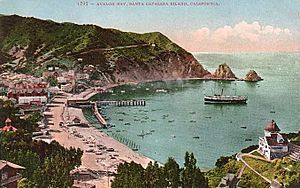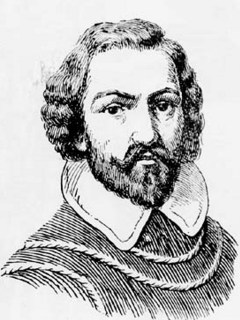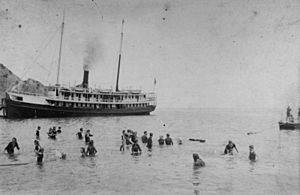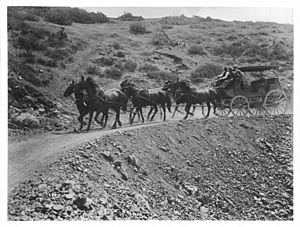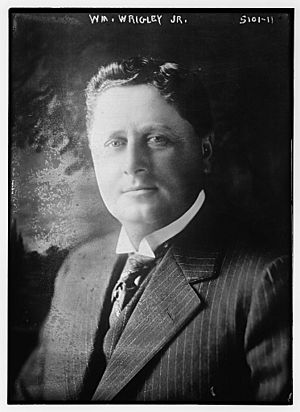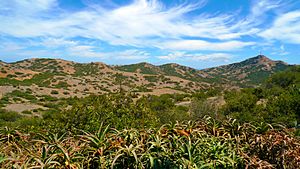History of Santa Catalina Island facts for kids
Santa Catalina Island, off the coast of California, has a long and interesting history. It was first home to Native Americans, who called themselves the Pimugnans. Later, European explorers arrived and claimed the island for Spain. Over time, the island became part of Mexico and then the United States. For many years, people used the island for things like hunting otters and even looking for gold. In the 1920s, a chewing gum businessman named William Wrigley, Jr. helped turn Catalina into a popular tourist spot. Most of the fun activities were in the town of Avalon, California. Since the 1970s, a group called the Catalina Island Conservancy has managed most of the island to protect its natural beauty.
Contents
Early Island Life: Native Americans
Before Europeans arrived, the Tongva tribe lived on Catalina Island. They called the island Pimu or Pimugna. They called themselves the Pimuvit or Pimugnans. These people lived in villages near what is now San Pedro and Playa del Rey. They often traveled to Catalina for trade.
Archaeologists have found signs that Pimugnan settlements began around 7000 BCE. The Pimugnans had villages all over the island. Their biggest villages were at the Isthmus, present-day Avalon, Shark/Little Harbor, and Emerald Bay. The Pimugnans were famous for mining and trading soapstone. This special stone was found in large amounts on the island. People highly wanted soapstone to make cooking pots. It was traded all along the California coast.
Scientists learn about these tribes from ancient trash piles called middens. These middens are mounds of broken abalone shells. Experts believe there are over 2,000 middens on Catalina Island. About 2,500 people may have lived on the island around 2000 BCE.
European Explorers Discover Catalina
The first European to visit Catalina Island was Juan Rodríguez Cabrillo. He was a Portuguese explorer sailing for Spain. On October 7, 1542, he claimed the island for Spain. He named it San Salvador after his ship.
More than 50 years later, another Spanish explorer, Sebastián Vizcaíno, found the island again. This was on November 24, 1602, the day before Saint Catherine's day. Vizcaíno renamed the island in her honor.
The arrival of the Spanish caused problems for the Pimugnans. They got sick from new diseases they had never known. Their trade and social networks were also disrupted by the new California missions. By the 1830s, most native people had either died or moved to the mainland. They went to work in the missions or on ranches.
Franciscan friars thought about building a mission on Catalina. But they decided not to because there was not enough fresh water. Spain claimed Catalina Island, but they did not have enough ships to stop foreigners from trading there. So, the island became a base for many visitors. Hunters from places like the Aleutian Islands and America set up camps. They hunted otters and seals for their valuable fur. These furs were sold for high prices in China.
Smuggling also happened on the island for a long time. Pirates found many hidden coves. The island was also close to the mainland and had few people. This made it perfect for secret activities. China Point, on the southwest end of Catalina, is still named after its past use by smugglers.
Catalina's Gold Rush Excitement
Catalina Island had a short-lived gold rush thanks to three otter hunters. George Yount found some promising gold samples in 1854. He told some disappointed gold miners about it before he died. Samuel Prentiss, the first non-native person to live permanently on Catalina, also heard about buried gold. He spent 30 years digging for it without success. Just before he died in 1854, he told Stephen Bouchette about the treasure.
That same year, news of Yount's gold samples spread. Bouchette claimed he found a rich gold vein. He got a lot of money to dig over 800 feet of tunnels. Some people think there was little gold, and it was a trick to get money to find the lost treasure. In 1878, Bouchette and his wife loaded their belongings onto a sailboat and were never seen again. No one knows if they found the treasure, got lost at sea, or simply went back to the mainland.
News of gold brought many hopeful miners to Catalina. By 1863, small boom towns appeared on the hills. In less than a year, miners registered 10,000 feet of claims. About 70 miners were actively working these claims. They dug tunnels by hand and camped out. There was only one store and one saloon to supply their needs. They faced many challenges. But they could send messages to the mainland in 45 minutes using homing pigeons. Mail took 10 days!
In 1864, the United States government stopped the mining. They worried that Confederate supporters might use the island during the American Civil War. Everyone was ordered off the island. A small group of Union soldiers stayed at the Isthmus for about nine months. Their barracks are the oldest building on the island. Today, it is home to the Isthmus Yacht Club. Even though there is no clear proof of gold on Catalina, the idea of a gold treasure kept people interested for decades.
Early Developers Shape Avalon (1860–1919)
In the 1860s, Augustus William Timms ran a sheep business on Catalina Island. His boat, the Rosita, also took people to Avalon Bay for swimming and fishing. The settlement in Avalon was first called Timms' Landing. By 1883, there were thirty tents and three wooden buildings there.
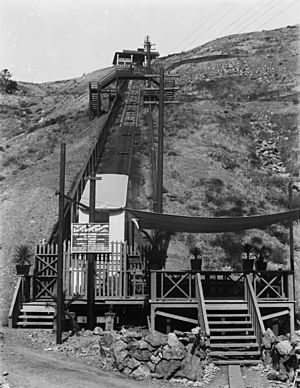
By the late 1800s, the island was mostly empty except for a few cattle herders. But it was only 20 miles (30 km) from Los Angeles. Los Angeles was growing very fast. This location helped turn Catalina into a popular vacation spot.
The first person to try to make Avalon a resort was George Shatto. He was a real estate investor from Michigan. Shatto bought the island for $200,000 in 1887. This was during a big real estate boom in Southern California. Shatto created the town that would become Avalon. He built the town's first hotel, the original Hotel Metropole, and a pier. Early maps called the town Shatto. But Shatto's sister-in-law, Etta Whitney, named it Avalon. This name came from a poem by Lord Tennyson about King Arthur. She said Avalon meant "Bright gem of the ocean" or "Beautiful isle of the blest."
Shatto planned Avalon's streets. He made it a vacation spot by holding a real estate auction in 1887. He also bought a steamship for daily trips to the island. In the summer of 1888, the small pioneer village opened as a busy resort town. But Shatto had to give the island back to the Lick estate a few years later because he could not pay his loan.
Avalon's oldest building still standing is the unique Holly Hill House. Peter Gano, an engineer, built it himself in 1889. He brought materials on his boat and used an old circus horse to haul them up the hill. He asked the woman he loved to join him, but she refused to move to an island. So, he lived there alone. After a fire in 1964, it was restored and is now a famous Avalon landmark.
The sons of Phineas Banning bought the island in 1891. They started the Santa Catalina Island Company to develop it as a resort. They wanted Catalina's rock to build a breakwater for their shipping company. They also had a new luxury boat, the Hermosa, for tourists. By owning Catalina, they would get rock and money from tourists.
The Banning brothers continued Shatto's dream for Avalon. They built many tourist places. They built a dance pavilion, added to the Hotel Metropole, and built an aquarium. They also created the Pilgrim Club, a gambling club for men. The Bannings also wanted people to see the rest of the island. They paved the first dirt roads into the island's center. There, they built hunting lodges and offered stagecoach tours. They also made areas like Lovers Cove, Sugarloaf Point, and Descanso Beach open to tourists. They built two homes, one in Descanso Canyon and one in Two Harbors. The Two Harbors home is now that village's only hotel.
On November 29, 1915, a fire burned half of Avalon's buildings. This included six hotels and several clubs. The Bannings refused to sell the island. They wanted to rebuild, starting with a new Hotel Saint Catherine. They planned to build it on Sugarloaf Point, a beautiful cliff at the north end of Avalon's harbor. They blasted away part of the point to start building. But they ran out of money. The hotel was eventually built in Descanso Canyon instead.
In 1917, a company bought the Chinese pirate ship Ning Po. It was built in 1753. They towed it to the Isthmus on Catalina Island. It became a restaurant and tourist attraction. The Ning Po stayed there until it burned during a Hollywood movie filming in 1938. In 1919, the Bannings had to sell parts of the island. This was due to debt from the fire and fewer tourists during World War I.
Wrigley's Vision for Catalina (1919–1975)
One of the main buyers was William Wrigley, Jr., who owned a chewing gum company. He visited Catalina with his wife, Ada, and son, Philip. Wrigley loved the island right away. In 1919, he bought most of the shares in the Santa Catalina Island Company. Wrigley worked hard to protect and promote the island. He spent millions on new buildings and attractions. He built a home on Mount Ada, named after his wife, so he could watch over his work.
When Wrigley bought the island, only two steamships, the Hermosa II and the SS Cabrillo, brought people to Catalina. To help the island grow, Wrigley bought another steamship, the SS Virginia. He renamed it the SS Avalon. He also designed a new steamship, the SS Catalina, which launched on May 3, 1924. These steamships brought many passengers to Catalina for years.
One of Wrigley's first goals was to build a better dance pavilion. He used Sugarloaf Point, which the Banning Brothers had cleared. He built a dance hall called Sugarloaf Casino. It was a ballroom and Avalon's first high school. But it was too small for Catalina's growing number of visitors. In 1928, the Casino was torn down to make room for a new one. Sugarloaf Rock was blasted away to give the new Casino a better ocean view. On May 29, 1929, Wrigley finished the new Catalina Casino. It was built in the Art Deco style. The lower level has the Avalon Theater. The upper level has the world's largest circular ballroom. It has a 180-foot (55 m) dance floor. In the 1930s, famous bands like Benny Goodman and Woody Herman played there.
Wrigley also tried to make the island famous through events. Starting in 1921, the Chicago Cubs baseball team, which Wrigley also owned, used the island for spring training. Players stayed at the Hotel St. Catherine and played on a field in Avalon Canyon. The Cubs trained on the island until 1951, except during World War II. Wrigley also started the Wrigley Ocean Marathon on January 15, 1927. He offered a prize to the first person to swim across the channel from the mainland. A Canadian swimmer named George Young won the prize. He was the only one to finish.
After Wrigley, Jr. died in 1932, his son, Philip K. Wrigley, took over. Philip continued his father's work to improve the island. During World War II, the island was closed to tourists. It was used for military training. Catalina's steamships were used to carry troops. Many military camps were set up. The U.S. Maritime Service trained in Avalon. The Coast Guard trained at Two Harbors. The Army Signal Corp had a radar station. The Office of Strategic Services trained at Toyon Bay. The Navy did underwater demolition training at Emerald Bay.
In September 1972, a group of Chicano activists called the Brown Berets visited Catalina. They raised a Mexican flag, saying the island belonged to all Chicanos. They believed the Guadalupe Hidalgo Treaty did not specifically mention the Channel Islands. The group camped near the Chimes Tower. They became a new tourist attraction. Local Mexican-Americans brought them food. After 24 days, a judge asked them to leave. They left peacefully on a tourist boat.
On February 15, 1975, Philip Wrigley gave 42,135 acres (17,051 ha) of the island to the Catalina Island Conservancy. He had helped start this group in 1972. This gave the Conservancy control of almost 90 percent of the island. The rest of the Santa Catalina Island Company still owns and runs many of the tourist attractions in Avalon. This includes the Catalina Visitors Country Club, Catalina Island Golf Course, Descanso Beach Club, and the Casino Ballroom.
Catalina's Recent History (1975–Present)
In May 2007, Catalina had a large wildfire called the 2007 Avalon Fire. About 4,750 acres (19.2 km2) of wildland burned. But only a few buildings were destroyed. This was thanks to 200 Los Angeles County firefighters. They were brought by U.S. Marine Corps helicopters and Navy hovercraft. In May 2011, another wildfire started near the Isthmus Yacht Club. 120 firefighters fought it. It burned 117 acres (47 ha) and was put out the next day.
In February 2011, water officials criticized Avalon for sewage spills. Since 2005, tens of thousands of gallons of sewage had reached the ocean in six spills. A report in June 2011 said Avalon had one of the 10 most polluted beaches in the United States. The problem was the city's old sewer system, made of clay and metal pipes. By 2011, the city had spent $3.5 million to fix the pipes. But the water was still not cleaner. In February 2012, the city was ordered to stop illegally releasing polluted water. After this order, the city spent another $5.7 million on sewer improvements. Because of these efforts, a 2014 report showed that water quality had improved. Avalon Beach was removed from the list of most polluted beaches.
In 2014, the Santa Catalina Island Company worked on several projects. These included a spa, a water facility, a community center, new shops, a new hotel, and 120 new homes. The biggest project was a new $6-million museum building on Metropole Street. It replaced the old museum in the Casino building. Some people in the community worried about how fast the town was changing.
In early 2020, during the COVID-19 pandemic, the island was closed to tourists.
In early 2024, a study found something interesting about rattlesnakes on Catalina Island. A professor named William Hayes discovered that these snakes are more defensive and less tame. They also bite more often with more venom during tests. This is likely because of new animals brought to the island. Rattlesnakes are sensitive creatures and react to changes around them. However, the rattlesnakes on the island are usually smaller than those on the mainland. This helps scientists understand island ecosystems better.


